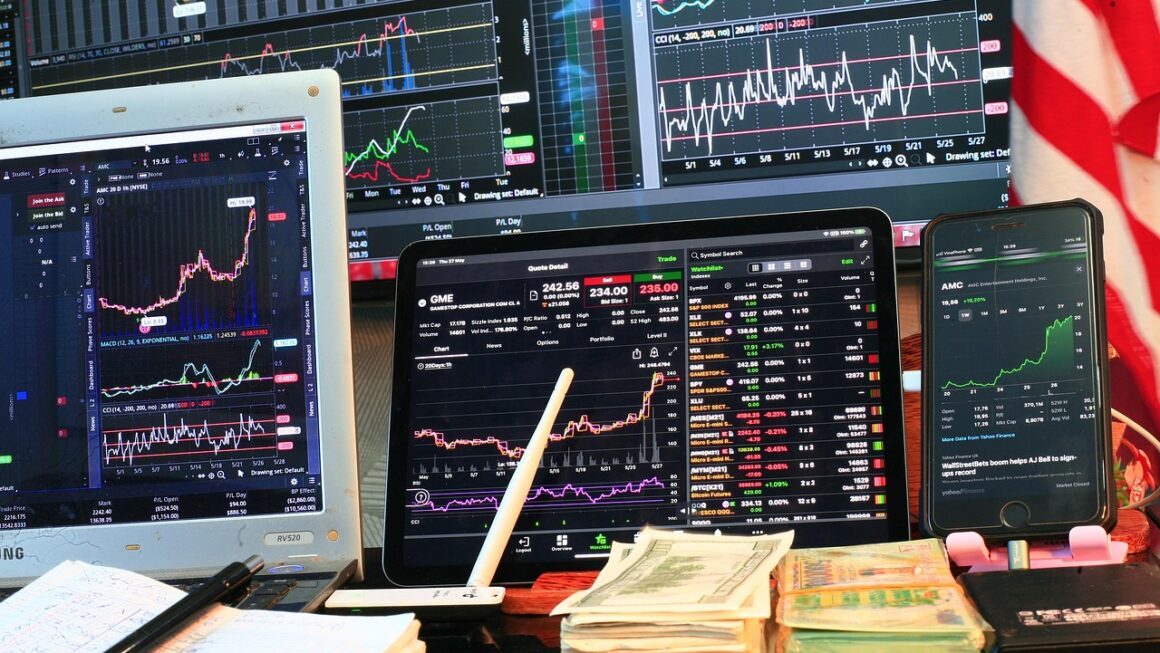Trading in the financial markets can be an exciting opportunity, but it also comes with inherent risks. One powerful tool that can amplify both gains and losses is leverage. Leverage trading, while offering the potential for significant returns, requires a deep understanding of its mechanics and associated risks. This comprehensive guide will explore the ins and outs of leverage trading, providing you with the knowledge necessary to make informed decisions.
What is Leverage Trading?
Defining Leverage
Leverage trading is essentially borrowing capital from a broker to increase your trading position beyond what your available cash would normally allow. It’s expressed as a ratio, such as 1:2, 1:10, 1:50, or even higher. For example, with a leverage of 1:10, you can control a position worth $10,000 with only $1,000 of your own capital. The broker effectively lends you the remaining $9,000.
- Key Takeaway: Leverage magnifies both potential profits and potential losses.
How Leverage Works in Practice
Let’s consider a simple example:
You want to buy shares of Company XYZ, currently trading at $100 per share. You have $1,000 to invest.
- Without Leverage: You can buy 10 shares ($1,000 / $100). If the stock price increases to $110, your profit is $100 (10 shares x $10 gain per share).
- With Leverage (1:10): With $1,000 and 1:10 leverage, you can control $10,000 worth of Company XYZ shares. This allows you to buy 100 shares ($10,000 / $100). If the stock price increases to $110, your profit is $1,000 (100 shares x $10 gain per share).
In this scenario, leverage significantly increased your profit potential. However, it’s crucial to remember that if the stock price decreases to $90, your loss would also be $1,000, wiping out your entire initial investment.
- Important Note: The broker charges interest or fees on the borrowed capital, often referred to as margin. This cost must be factored into your trading strategy.
Understanding Margin and Margin Calls
What is Margin?
Margin is the initial deposit you need to open and maintain a leveraged position. It acts as collateral for the borrowed funds. The margin requirement is usually expressed as a percentage of the total position size. For instance, a 10% margin requirement means you need to deposit 10% of the position’s value as margin.
- Example: To control a $10,000 position with a 10% margin requirement, you need to deposit $1,000 as margin.
What is a Margin Call?
A margin call occurs when the value of your leveraged position decreases to a point where your equity (the difference between the position’s value and the borrowed amount) falls below the maintenance margin requirement. The maintenance margin is a minimum amount of equity you must maintain in your account.
- What happens during a margin call? The broker will notify you to deposit additional funds to bring your equity back above the maintenance margin level. If you fail to do so, the broker may automatically close your position to cover the losses, potentially resulting in a significant financial loss.
- Avoiding Margin Calls:
Use stop-loss orders to limit potential losses.
Monitor your positions regularly.
Maintain sufficient funds in your account to cover potential margin calls.
Avoid over-leveraging your account.
Example of a Margin Call
Let’s say you open a $10,000 position with 1:10 leverage, requiring a $1,000 margin. Your maintenance margin is set at 5%. This means you need to maintain $500 (5% of $10,000) in equity. If your position loses value and your equity falls below $500, you will receive a margin call. If you don’t deposit additional funds, the broker will close your position, potentially at a significant loss.
Risks and Benefits of Leverage Trading
Potential Benefits
- Amplified Profits: As demonstrated earlier, leverage can significantly increase potential profits if the market moves in your favor.
- Increased Trading Power: Allows you to control larger positions with a smaller amount of capital.
- Diversification Opportunities: Frees up capital for other investment opportunities.
- Potential for Short Selling: Leverage is often used in short selling strategies, allowing traders to profit from declining markets.
Potential Risks
- Magnified Losses: Just as leverage amplifies profits, it also magnifies losses. A small adverse price movement can wipe out your entire investment.
- Margin Calls: The risk of receiving a margin call can be stressful and potentially lead to forced liquidation of your positions at unfavorable prices.
- Interest and Fees: Brokers charge interest and fees on leveraged positions, which can erode profits over time.
- Emotional Trading: The high-stakes nature of leverage trading can lead to emotional decision-making, resulting in poor trading choices.
- Increased Complexity: Leverage trading adds complexity to the trading process, requiring a deeper understanding of market dynamics and risk management.
- Key Takeaway: Understand and accept the inherent risks of leverage before engaging in leverage trading. Risk management is paramount.
Strategies for Managing Risk with Leverage
Stop-Loss Orders
A stop-loss order is an instruction to your broker to automatically close your position if the price reaches a specific level. This limits potential losses and prevents your position from spiraling out of control.
- Example: If you buy a stock at $100 with 1:10 leverage and place a stop-loss order at $95, the broker will automatically sell your shares if the price drops to $95, limiting your loss to $5 per share.
Position Sizing
Carefully calculate the size of your leveraged positions to avoid over-leveraging your account. A general rule of thumb is to risk only a small percentage (e.g., 1-2%) of your trading capital on any single trade.
- Formula: Position Size = (Account Risk / Risk per Share) / Leverage
Risk-Reward Ratio
Assess the potential reward relative to the potential risk before entering a leveraged trade. Aim for a risk-reward ratio of at least 1:2 or higher, meaning you are risking $1 to potentially make $2 or more.
Monitoring Your Positions
Regularly monitor your leveraged positions and be prepared to adjust your strategy as needed. Market conditions can change rapidly, and it’s crucial to stay informed and adapt accordingly.
Diversification
Avoid putting all your eggs in one basket. Diversify your leveraged positions across different assets and markets to reduce overall risk.
Start Small
Begin with small amounts of leverage to gain experience and develop your risk management skills. Gradually increase your leverage as you become more comfortable and confident.
Choosing a Broker for Leverage Trading
Regulation and Security
Ensure that the broker is regulated by a reputable financial authority, such as the Securities and Exchange Commission (SEC) in the United States or the Financial Conduct Authority (FCA) in the United Kingdom. This provides a level of protection and ensures that the broker adheres to certain standards of conduct. Also, check for security measures to protect your funds and data.
Leverage Offered
Compare the leverage offered by different brokers. Be aware that higher leverage may seem appealing, but it also increases risk. Choose a leverage level that aligns with your risk tolerance and trading strategy.
Trading Platform and Tools
Evaluate the broker’s trading platform and available tools. A user-friendly platform with advanced charting capabilities, real-time market data, and order execution features can enhance your trading experience.
Fees and Commissions
Compare the fees and commissions charged by different brokers. Look for transparent pricing and avoid brokers with hidden fees. Consider the cost of margin interest, spreads, and other transaction costs.
Customer Support
Choose a broker that offers reliable and responsive customer support. You may need assistance with technical issues, account inquiries, or margin calls, so it’s important to have access to prompt and helpful support.
Example Broker Considerations
While specific broker recommendations depend on individual needs, here are some factors to consider:
- For beginners: Look for platforms with educational resources and demo accounts.
- For experienced traders: Prioritize platforms with advanced charting tools and order types.
- For specific asset classes: Ensure the broker offers the markets and assets you want to trade with leverage.
Conclusion
Leverage trading can be a powerful tool for experienced traders, but it is not without its risks. Understanding the mechanics of leverage, margin requirements, and risk management strategies is crucial for success. Before engaging in leverage trading, carefully assess your risk tolerance, develop a solid trading plan, and choose a reputable broker. Remember, responsible leverage trading involves disciplined risk management and a commitment to continuous learning. By taking a cautious and informed approach, you can harness the potential benefits of leverage while mitigating the associated risks.




